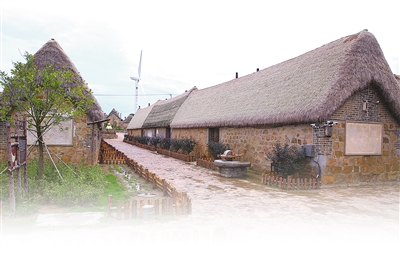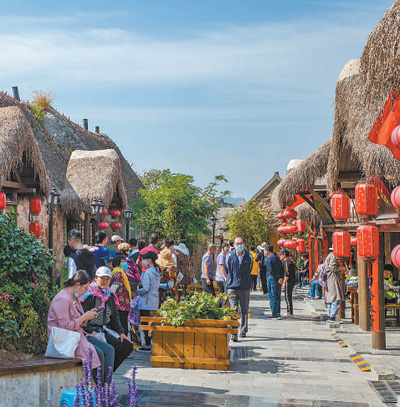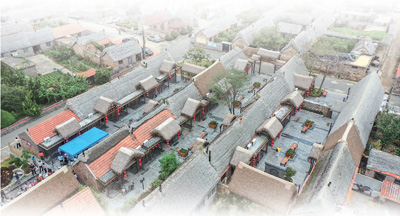




- BRNN
- BRI News
- BRNN News
- Database
Official Documents Polices and Regulations
Inter-government Documents International Cooperation BRI Countries
Business Guide Economic Data BRI Data
Trade
Investment Projects Latest projects
Cases - Content Pool

Photo shows seaweed-thatched houses in Dongchudao village, Rongcheng city, east China's Shandong Province. (Photo/Yang Zhili)
In a seaside fishing village in Rongcheng city, a county-level city administered by Weihai city, east China's Shandong Province, seaweed-thatched houses are a unique sight to behold.
The houses, made of stone walls and seaweed roofs, have a distinctive appearance with fluffy textures. They are representative examples of eco-friendly traditional dwellings in the coastal region in eastern Shandong Province.
Currently, Rongcheng boasts over 300 traditional fishing villages, with seaweed-thatched houses as their iconic feature. Among them, 25 villages have been recognized at the national and provincial levels as traditional villages.
One of these villages is Dongchudao village. Surrounded by the sea on three sides, the village stretches along a 10-kilometer coastline. It stands out as one of the best-preserved villages in eastern Shandong, with 144 households and 650 seaweed houses.
The construction of seaweed-thatched houses has a long history in this area. Local residents use thick stones for walls and dried seaweed as roofing material. This traditional house building technique was officially recognized as an intangible cultural heritage of Shandong Province in 2006.

Photo shows seaweed-thatched houses in Dongdun village, Rongcheng city, east China's Shandong Province. (Photo/Yang Zhili)
"The seaweed washed ashore is gradually decomposed by microorganisms, releasing the stored carbon as carbon dioxide into the air. However, by drying and using the seaweed to build houses, its usage time can be extended to over a decade, thereby lowering the speed of carbon dioxide emissions," said Wang Shanshan, an associate professor from Weihai Ocean Vocational College, who added that seaweed houses contribute positively to the reuse of seaweed and environmental conservation.
In 2015, Dongchudao village initiated a renovation project for those seaweed-thatchede houses that needed repairs. A team of professionals was invited to repair and reinforce the structures, which were subsequently inspected on-site by the local cultural relics department.
Since 2013, Rongcheng has designated seaweed houses and courtyards with significant historical, cultural, and artistic value as protected cultural relic units.
To preserve the authenticity and integrity of traditional villages, the city has carried out proactive maintenance repairs and protective development on the seaweed-thatched houses in these villages. Presently, houses in seven villages have attained the status of provincial-level protected cultural relic units in Shandong Province.
Furthermore, the local government in Rongcheng city has recruited young local talents who possess a genuine passion for the preservation of ancient villages. To date, over 2,000 individuals with diverse expertise have been cultivated and integrated into the workforce.

Aerial picture shows seaweed-thatched houses in Dongchudao village, Rongcheng city, east China's Shandong Province. (Photo/Yang Zhili)
Liucun village is a traditional village in Rongcheng city. Surrounded by mountains, it has a history of over 700 years and is home to more than 140 seaweed-thatched houses.
"Constructing a seaweed-thatched house involves over 70 steps," said Cheng Zhongan, director of the villagers' committee of Liucun village. The construction process encompasses material preparation, wall construction, and thatching the roof, Cheng added.
"Thatching the roof with seaweed is the most critical step. The thickest part of the thatch can reach up to 4 meters. It takes a team of three or four skilled craftsmen over 10 days to complete a single thatched roof," said Cheng.
Rongcheng city has launched a project to improve the living environment in traditional villages, with an investment exceeding 500 million yuan (about $68.82 million). This initiative focuses on addressing the deficiencies in infrastructure, including water, electricity, roads, gas, and heating.
Ten years ago, Yu Haiyang, a native in Yandunjiao village, Rongcheng, returned to embark on an entrepreneurial journey.
Yandunjiao village boasts over 1,300 well-preserved seaweed-thatched houses, many of which had remained vacant for a long period of time. After careful consideration, Yu secured leases for three of these houses, intending to transform them into a facility that provides food services, accommodation, and other activities for tourists.
Yu and the villagers' committee agreed that the exterior of the seaweed-thatched houses must remain unchanged. It was not until after the renovations were completed and approved by the villagers' committee that Yu's business was opened to welcome guests.
"My business has been thriving. Last year, I earned over 100,000 yuan," Yu said. He added that in recent years, more and more young people have chosen to return to the village and contribute to the cultural tourism industry, leading to an increasing number of tourists visiting the village.
Nowadays, Yandunjiao village has more than 70 houses that provide food services, accommodation, and other activities for tourists. Over 95 percent of the villagers are involved in the tourism service industry. In 2023, the village welcomed over 100,000 tourist visits, generating tourism revenue of over 2 million yuan.
Rongcheng city is committed to continuing the preservation of its traditional villages and the development of tourism, said a leading official of the city, adding that by leveraging regional characteristics like the ancient villages and seaweed-thatched houses, the villages are able to thrive in conservation while being rejuvenated through revitalization brought by tourism.

Tel:86-10-65368972, 86-10-65369967